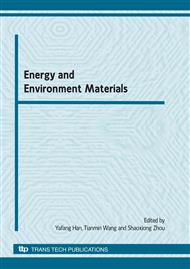[1]
K. Matsuzawa, T. Shido, Y. Iwasawa: Langmuir Vol. 19 (2003), p.2756.
Google Scholar
[2]
N. Chand, S. Verma: J. Fire. Sci. Vol. 9 (1991), p.251.
Google Scholar
[3]
P.W. Haycock, G.A. Horley, K.C. Molloy, C.P. Myers, S.A. Rushworth, L.M. Smith: J. Phys. IV Vol. 11 (2001), p.1045.
Google Scholar
[4]
H. Li, X.J. Huang, L.Q. Chen: Solid State Ionics Vol. 123 (1999), 189.
Google Scholar
[5]
M.Z. Xue, Z.W. Fu: Electrochem. Commun. Vol. 8 (2006), p.1250.
Google Scholar
[6]
H. Bryngelsson H, J. Eskhult, K. Edstrom, L. Nyholm: Electrochim. Acta Vol. 53 (2007), p.1062.
Google Scholar
[7]
H. Bryngelsson, J. Eskhult, L. Nyholm, M. Herranen, O. Alm, K. Edstrom: Chem. Mater. Vol. 19 (2007), p.1170.
Google Scholar
[8]
Y. X Zhang, G.H. Li, L.D. Zhang: Chem. Lett. Vol. 33 (2004), p.334.
Google Scholar
[9]
L. Guo, Z.H. Wu, T. Liu, W.D. Wang, H, S, Zhu: Chem. Phys. Lett. Vol. 318 (2000), p.49.
Google Scholar
[10]
Z.T. Deng, F.Q. Tang, D. Chen, X.W. Meng, L. Cao, B.S. Zou: J. Phys. Chem. B Vol. 110 (2006), p.18225.
Google Scholar
[11]
B.J. Li, Y.B. Zhao, X.M. Xu, C.L. Zhang, Z.S. Wu, Z.J. Zhang: Chem. Lett. Vol. 35, (2006), p.1026.
Google Scholar
[12]
G.P. Ren, C.R. Wang, J.N. Xia, J. Liu, H.J. Zhong: Mater. Lett. Vol. 63 (2009), p.605.
Google Scholar
[13]
K.J. Rao, B. Vaidhyanathan, M. Ganguli, P.A. Ramakrishnan: Chem. Mater. Vol. 11 (1999), p.882.
Google Scholar
[14]
Y. Wang, J.Y. Lee: J. Power Sources Vol. 144 (2005), p.220.
Google Scholar
[15]
V. Subramanian, W.W. Burke, H.W. Zhu, B. Q Wei: J. Phys. Chem. C Vol. 112 (2008), p.4550.
Google Scholar
[16]
L.P. Xu, Y.S. Ding, C.H. Chen, L.L. Zhao, C. Rimkus, R. Joesten, S.L. Suib: Chem. Mater. Vol. 20 (2008), p.308.
Google Scholar
[17]
S. Cho, S.H. Jung, K.H. Lee: J. Phys. Chem. C Vol. 112 (2008), p.12769.
Google Scholar
[18]
J.J. Tang, Y. Wang, Z. Jiao, M. Wu: Mater. Lett. Vol. 63 (2009) p.1481.
Google Scholar
[19]
Y. Wang, J.Y. Lee: Electrochem. Commun. Vol. 5 (2003), p.292.
Google Scholar
[20]
Z.T. Deng, D. Chen, F.Q. Tang, X.W. Meng, J. Ren, L. Zhang: J. Phys. Chem. C Vol. 111 (2007), p.5325.
Google Scholar


